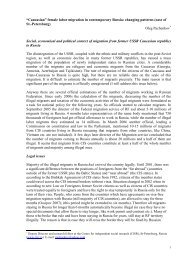THORIUM AS AN ENERGY SOURCE - Opportunities for Norway ...
THORIUM AS AN ENERGY SOURCE - Opportunities for Norway ...
THORIUM AS AN ENERGY SOURCE - Opportunities for Norway ...
You also want an ePaper? Increase the reach of your titles
YUMPU automatically turns print PDFs into web optimized ePapers that Google loves.
Thorium as an Energy Source - <strong>Opportunities</strong> <strong>for</strong> <strong>Norway</strong><br />
cycle should not be considered to reduce radiotoxicity, because a fast reactor requires a much<br />
higher fissile inventory. The problem is the U-233 in the spent fuel.<br />
6.1.2 Closed Thorium Cycle<br />
In a closed cycle, the spent fuel is reprocessed to recycle U-233 and thorium and possibly also the<br />
other produced actinides, in particular protactinium. The ideal is a self-sustaining cycle, i.e. after<br />
a number of cycles there is no further need <strong>for</strong> topping fuel. Self-sustaining cycles are in principle<br />
possible <strong>for</strong> thermal as well as <strong>for</strong> fast reactors. In thermal reactors, this is only possible if there<br />
is an excellent neutron economy, on-line refuelling capability and, preferably, on-line removal of<br />
fission products. The best systems are molten-salt reactors (MSRs), followed by C<strong>AN</strong>DU reactors<br />
and HTRs. However, in the latter two reactors, the maximum burnup that can be achieved is<br />
limited. Accelerators could also provide additional neutrons to facilitate a self-sustaining cycle<br />
(see Chapter 6.2).<br />
Figure 6.1 shows some results <strong>for</strong> a C<strong>AN</strong>DU reactor with HEU topping. The radiotoxicity of the<br />
waste is shown <strong>for</strong> the case if only uranium is recycled (curve B). Up to 1000 years, the remaining<br />
toxicity is caused mainly by Pu-238, and later by protactinium-231 (Pa-231). If plutonium and<br />
protactinium are recycled, it is demonstrated [137] that after two recyclings and after 1000 to<br />
2000 years of storage, the radiotoxicity of the waste is already below the level of the uranium ore<br />
needed <strong>for</strong> fuel fabrication <strong>for</strong> the once-through PWR.<br />
Figure 6.1: Actinide Radiotoxicity of the Waste if Thorium is used in a C<strong>AN</strong>DU Reactor with<br />
Once-through Operation and HEU as Topping Material (curve A).<br />
Curve B shows the actinide radiotoxicity of a C<strong>AN</strong>DU with HEU topping and recycling<br />
of U in equilibrium (curve B). Further reduction is possible if also Pu and Pa are<br />
recycled. References are the spent fuel of standard once-through C<strong>AN</strong>DU (curve C)<br />
and PWR reactors (curve P) and the necessary U ore <strong>for</strong> a PWR (curve O).<br />
The closed thorium cycle in a fast reactor breeds U-233. The radiotoxicity of the spent fuel could<br />
be further reduced if the uranium and the actinides are recycled. Due to the fast neutron<br />
spectrum, fissioning of produced minor actinides is more efficient than in a thermal reactor. A<br />
self-sustaining fast reactor based on the Th/U-233 cycle is possible, albeit that the doubling time<br />
of U-233 is quite large (about 250 years). Improved safety feed-back coefficients are obtained. The<br />
72

















